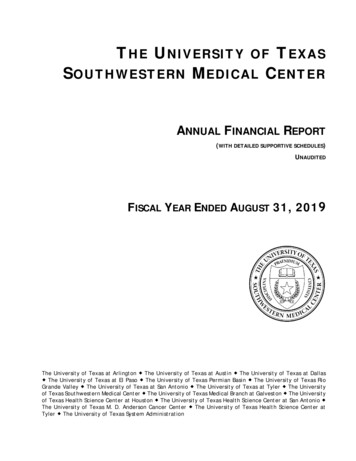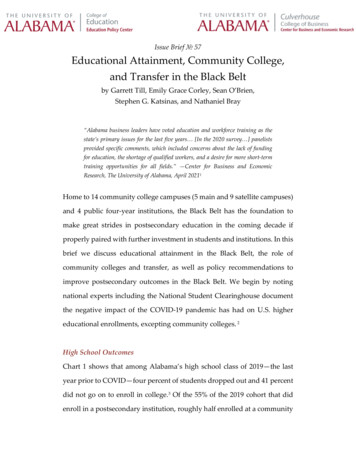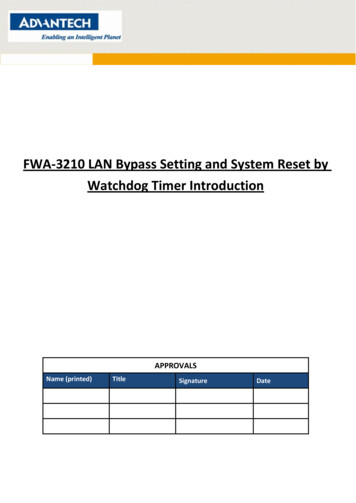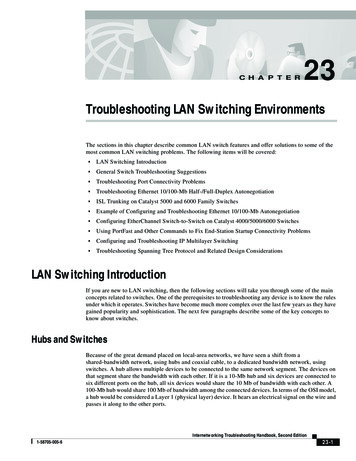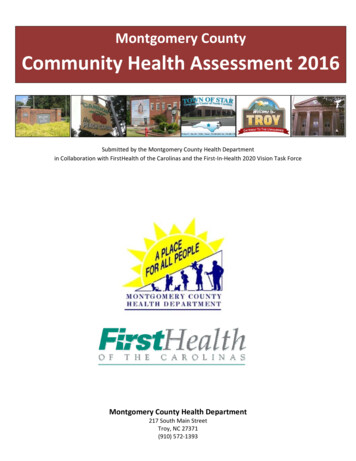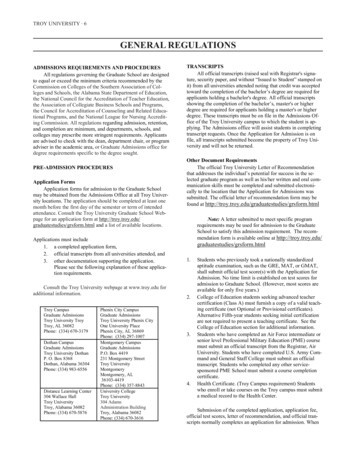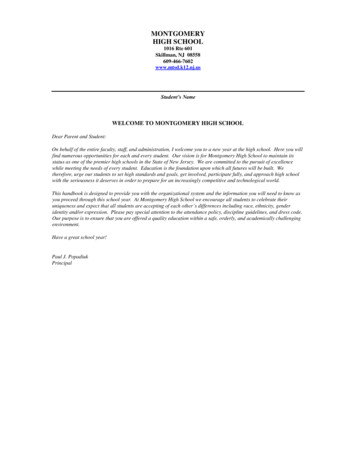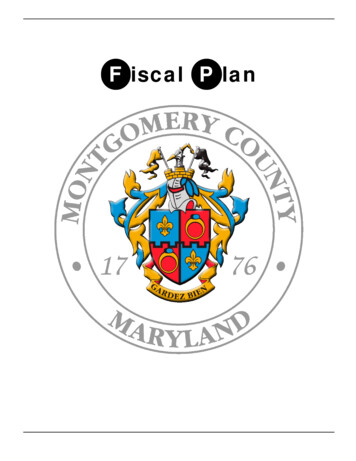
Transcription
F iscal P lan
Table of ContentsTRANSMITTAL MEMORANDUMNON-TAX SUPPORTED FUNDS: SIX YEARFISCAL PLANSMONTGOMERY COUNTY FUNDSMontgomery County GovernmentTAX SUPPORTED FUNDSPublic Service Program (PSP)Fiscal Plan Summary1-2Capital Improvements Program (CIP)General Information: CIP2-1Debt Capacity Analysis2-3General Obligation Bond Adjustment Chart2-4Current Revenue Requirements for the CIP2-5Cable Television Communications Plan7-3Montgomery Housing Initiative Fund7-7Water Quality Protection Fund7-8Community Use of Public Facilities Fund7-9Bethesda Parking District Fund7-10Silver Spring Parking District Fund7-11Wheaton Parking District Fund7-12Solid Waste Collection Fund7-13Solid Waste Disposal Fund7-14TAX SUPPORTED FUNDS: SIX YEAR FISCALPLANSLeaf Vaccuming Fund7-15Permitting Services Fund7-16Montgomery County GovernmentLiquor Control Fund7-173-3Risk Management Fund7-18Silver Spring Urban District Fund3-4Central Duplicating, Mail, & Records Mgmt. Fund7-19Wheaton Urban District Fund3-5Employee Health Benefits Self Insurance Fund7-19Fire Tax District Fund3-6Motor Pool Fund7-20Mass Transit Facilities Fund3-7Recreation Non-Tax Supported7-21Recreation Fund3-8Inmate Advisory Council Fund7-21Economic Development Fund3-9Bethesda Urban District FundMontgomery CollegeMontgomery College Current Fund4-1Maryland-National Capital Park andPlanning Commission (M-NCPPC)M-NCPPC Enterprise Fund8-1Washington Suburban Sanitary CommissionMaryland-National Capital Park andPlanning CommissionWater and Sewer Operating FundsM-NCPPC Administration Fund5-1M-NCPPC Park Fund5-2Department Highlights9-110-1APPENDICESDebt ServiceDebt Service Fund6-1Change in Ending Fund Balance11-2Trend and Projections11-4Changes in Assumptions: Economic, Demographic, and 11-5RevenuesRevenue Summary11-9Non Agency Uses of Resources11-10Revenues12-1PSP Fiscal Policy13-1CIP Fiscal Policy14-1Glossary15-1Acronyms16-1
THIS PAGE INTENTIONALLY LEFT BLANK
CreditsSignificant contributions have been made by many individuals to the evolution of this Fiscal Plan over recent yearsthrough leadership, conceptual development, technical refinement, and persistent questioning. Their support hasbeen essential and is appreciated.COUNTY EXECUTIVEMarc ElrichCHIEF ADMINISTRATIVE OFFICERRichard S. MadalenoCOUNTY COUNCIL GOVERNMENT OPERATIONS AND FISCAL POLICY COMMITTEENancy Navarro, ChairAndrew FriedsonSidney KatzDIRECTOR, OFFICE OF MANAGEMENT AND BUDGETJennifer BryantDIRECTOR, DEPARTMENT OF FINANCEMichael J. CoveyouEXECUTIVE DIRECTOR, OFFICE OF THE COUNTY COUNCILMarlene MichaelsonOMB / FINANCEMary Beck, Joshua Watters, Chris Mullin, Crystal Sallee BrockingtonNancy Feldman, Karen Hawkins, Kimberly Williams,David PlattMONTGOMERY COUNTY PUBLIC SCHOOLSDaniel K. MarellaMARYLAND-NATIONAL CAPITAL PARK AND PLANNING COMMISSIONJohn KrollWASHINGTON SUBURBAN SANITARY COMMISSIONLetitia Carolina-PowellMONTGOMERY COLLEGELinda HickeyTECHNICAL SUPPORTDavid Jeo
ADDITIONAL CREDITSMuch of the work on the Fiscal Plan components, especially regarding Special Funds, has been led by specific OMBstaff, working with the leadership and staff of other departments and agencies whose contributions have beencrucial to both the technical development of the tools and to the substance of recommendations for considerationby the Executive and Council. The names of the respective OMB staff are listed below as points of contact forfurther information and can be reached at 240.777.2800.SPECIAL FUNDOMB STAFFCable TelevisionMontgomery Housing InitiativeCommunity Use of Public FacilitiesEconomic DevelopmentFire Tax DistrictFleet Management Services (Motor Pool)Liquor ControlMass Transit FacilitiesM-NCPPCAdministrationM-NCPPC EnterpriseM-NCPPC ParkMontgomery College Current FundParking DistrictsPermitting ServicesCentral Duplicating/Print and MailRecreationSelf-Insurance: Liability & PropertySelf-Insurance: Employee Health BenefitsSolid Waste Refuse CollectionSolid Waste DisposalLeaf VacuumingUrban DistrictsWater Quality ProtectionRecreation non-tax supportedInmate Advisory Council FundFelicia HyattPofen SalemDeborah LambertPofen SalemRachel SilbermanGary NalvenEstela Boronat de GomesDerrick HarriganRichard HarrisRichard HarrisRichard HarrisRafael MurphyTaman MorrisRafael MurphyGary NalvenAnita AryeeteyEstela Boronat de GomesCorey OrloskyRichard HarrisRichard HarrisDerrick HarriganLindsay LucasRichard HarrisAnita AryeeteyRachel Silberman
OFFICE OF MANAGEMENT AND BUDGETMarc ElrichCounty ExecutiveJennifer BryantDirectorMEMORANDUM19-Apr-21TO:Interested ReadersFROM:Jennifer Bryant, DirectorSUBJECT: FY22-27 Fiscal PlanExecutive Summary:The County Executive's recommended budget, released on March 15, 2021 is a balanced approach that responds toand begins the recovery from the COVID-19 pandemic while remaining focused on the County's long-term goals of socialjustice, racial equity, and community resiliency in a fiscally responsible manner. Federal aid received by the County throughthe Coronavirus Aid, Relief, and Economic Security (CARES) Act and the American Rescue Plan Act, as well as the Countyaggressively seeking FEMA reimbursement for eligible expenditures, has provided much needed assistance in the County'sresponse to the COVID-19 pandemic and helping close a significant FY22 budget gap. However, due to many economicpressures, the shortfalls between expected budget demands and estimated revenues will likely continue into the foreseeablefuture even after the County's response to the COVID-19 pandemic is complete. This is evident in the current fiscal plan,which projects a 1.2 percent decrease in resources available to fund agency spending in FY23.In total, FY22 spending increases 2.2 percent, and tax-supported spending across all agencies increases 1.2 percent,including debt service. This includes funding for all the County's collective bargaining agreements and funds retiree healthbenefits at the required the level. The County Executive recommends an average weighted property tax rate of 0.9785 per 100 of assessed value (which is within the Charter Limit), and a 692 credit for each owner-occupied residence to support aprogressive property tax structure in the County.The recommended budget fully funds the Board of Education's request and represents a local school funding amountthat is 40.2 million above the State minimum funding requirement. While the enrollment in the County's public schoolsdecreased this year (enrollment is projected to increase in FY23-FY27), the effects of a decade of rapid enrollment growthcontinues to challenge our school system and our County budget. As the County's total population continues to increase andage, demands on other County services such as home health care, senior transportation, emergency response, libraries, andrecreation also increase.Due to the County's response to COVID-19 pandemic, reserves are estimated to be lower than the 10 percent policy
target in FY21-FY23. When emergencies require the reserves to go below the 10 percent target, it is the County's policy toensure reserves achieve the policy target within three years. The tax supported Fiscal Plan shows reserves increasing from8.9 percent of Adjusted Governmental Revenues (AGR) in FY21 to 9.6 percent in FY22, 9.8 percent in FY23, and 10percent in FY24-FY27.As the County Council considers and acts on the operating budget, the County Executive believes it is essential thatit adhere to the general parameters of his recommended budget. Additional spending beyond the recommended level orreducing ongoing revenues, without corresponding expenditure reductions, would further increase the gap in FY23. Any newrevenues to support additional ongoing spending are likely to be very constrained. Continued adherence to prudent fiscalpolicies that protect residents and taxpayers will allow the County to maintain current service levels and address importantpriorities.Background:The recommended FY22-27 fiscal plans for the tax supported and non-tax supported funds of the agencies ofCounty government are provided for your information. Many of these fiscal plans were initially published in the FY22-27Recommended Operating Budget and Public Services Program (March 15, 2021) available athttp://montgomerycountymd.gov/operatingbudget.As in past years, this information is intended to assist the County Council and other interested parties as theCounty Executive's recommended budget is considered during the Council's budget work sessions this spring.Interested readers should note that the fiscal plans included in this publication are not intended to be prescriptive butare instead intended to present one possible outcome of policy choices regarding taxes, user fees, and spending decisions.Other important assumptions are explained in footnotes at the bottom of each fiscal plan display. One significantbenefit of presenting multi-year projections is that the potential future year impacts of current policy decisions can beconsidered by decision makers when making fiscal decisions in the near term. The County's fiscal policies support:prudent and sustainable fiscal management: constraining expenditure growth to expected resources;identifying and implementing productivity improvements;avoiding the programming of one-time revenues to on-going expenditures;growing the local economy and tax base;obtaining a fair share of State and Federal Aid; maintaining prudent reserve level;minimizing the tax burden on residents; andand managing indebtedness and debt service very carefully.The Recommended Budget is consistent with the County's fiscal policies adopted through March 2021. As statedearlier, due to the County's response to COVID-19 pandemic, reserves are estimated to be lower than the 10 percent policytarget in FY21-FY23. In compliance with the County's fiscal policy, reserves are projected to return to the policy level byFY24.Fiscal Plan for the Tax Supported Funds:The recommended fiscal planning objectives for FY22-27 for the tax supported funds are:Adhere to sound fiscal policies;Reserves (operating margin and the Revenue Stabilization Fund) will return the policy level by FY24;The average weighted property tax rate is 0.9785 per 100 of assessed value and assumes a 692 credit to eachPage 2County Executive's FY22-27 Fiscal Plan
owner-occupied household;Assume property tax revenues at the Charter Limit during FY23-27 in the fiscal plan using the income tax offsetcredit;Manage fund balances in the non-tax supported funds to established policy levels where applicable;Assume current State aid formulas but continue vigorous efforts to increase State (and Federal) operating and capitalfunding;Maintain priority to economic development and tax base growth:seize opportunities to recruit and retain significant employers compatible with the County's priorities;give priority to capital investment that supports economic development/tax base growth.Maintain essential services;Limit exposure in future years to rising costs by controlling baseline costs and allocating one-time revenues to one-timeexpenditures, whenever possible;Manage all debt service commitments very carefully, consistent with standards used by the County to maintain highcredit ratings and future budget flexibility. Recognize the fixed commitment inherent in all forms of multi-yearfinancing (long-term bonds, shorter-term borrowing, and lease-backed revenue bonds) that must be accommodatedwithin limited debt capacity;Program PAYGO to be at least 10 percent of anticipated General Obligation Bond levels to contain future borrowingcosts in FY23-27 (FY22 is less than the 10 percent policy level due to operating budget fiscal constraints and to beginto restore reserves levels);For capital investment, allocate debt, current revenue, and other resources made available by the fiscal objectives aboveaccording to priorities established by policy and program agendas; andFor services, allocate resources consistent with policy and program agendas.The major challenges for FY22-27 will be to aggressively manage on-going costs; strengthen essential services; andcontinue making targeted improvements to critical service areas including responding to and recovery from the COVID-19pandemic, education, economic development, re-imagining public safety, the social safety net, affordable housing, andtransportation within projected available resources.Fiscal Plan for the Non-Tax Supported Funds:By definition, each of the non-tax supported (fee-supported) funds is independent, covering all operating and capitalinvestment expenses from its designated revenue sources. The fiscal health of each fund is satisfactory; though looking ahead,some funds will need to meet expected challenges by increasing fees and/or reducing expenditures. A Government AccountingStandards Board requirement for OPEB liability reporting is shown in the non-tax supported funds on a multi-year allocationschedule.Conclusion:Montgomery County's long-term fiscal health is strong due to its underlying economy and the financial managementpolicies endorsed by its elected officials. Nonetheless, the County will continue to face significant challenges in the yearsahead. The FY22-27 Fiscal Plans reflect these challenges in their assumptions and projections.Comments on the Fiscal Plans that follow are encouraged.JB:cmTransmittal MemorandumPage 3
Attachment: FY22-27 Fiscal Plan for Montgomery County, Marylandcc: Marc Elrich, County ExecutiveCouncilmembers, Montgomery County CouncilRichard S. Madaleno, Chief Administrative OfficerFariba Kassiri, Deputy Chief Administrative OfficerDr. Jack Smith, Superintendent, Montgomery County Public SchoolsDr. DeRionne P. Pollard, President, Montgomery CollegeCasey Anderson, Chair, Montgomery County Planning BoardStacy Spann, Executive Director, Housing Opportunities CommissionKeith Miller, Executive Director, Revenue AuthorityMichael Coveyou, Director, Department of FinanceMarlene Michaelson, Executive Director, Montgomery County CouncilPage 4County Executive's FY22-27 Fiscal Plan
Tax Supported FundsPublic Service ProgramFiscal Plan SummaryCapital Improvements ProgramGeneral Information: CIPDebt Capacity AnalysisGeneral Obligation Bond Adjustment ChartCurrent Revenue Requirements for the CIPTax Supported Funds1-1
1-2Tax Supported FundsCounty Executive's FY22-27 Fiscal Plan
Tax Supported Funds1-3
THIS PAGE INTENTIONALLY LEFT BLANK1-4Tax Supported FundsCounty Executive's FY22-27 Fiscal Plan
Capital ImprovementsProgram (CIP)GENERAL INFORMATIONInvestment in the construction of public buildings, roads, and other facilities planned by County public agencies is generallybudgeted in the Capital Improvements Program (CIP). The six-year CIP is the County's plan for constructing the infrastructureto implement approved master plans and the facilities required to deliver government programs and services and to complementand support private development. The CIP is a multi-year spending plan, including capital expenditure estimates, fundingrequirements, and related program data for all County departments and agencies with capital projects. The capital budget includesrequired appropriation, expenditures, and funding for the upcoming fiscal year.The CIP is by law (for the first year) and by policy (for the second through sixth years) a balanced plan, where plannedexpenditures do not exceed anticipated resources to fund them. The CIP is supported by a variety of funding sources.The tax supported portion of the CIP is funded by General Obligation and other long- and short-term debt (for which debt serviceis paid from revenues from one of the County taxes), Current Revenues from a County tax source, or an inter-governmentalsource.The non-tax supported portion of the CIP may be funded by current revenues from a non-tax source, or debt, with the debtservice paid from the non-tax source.IMPACT OF THE CIP ON THE PUBLIC SERVICES PROGRAM/OPERATING BUDGETThe CIP impacts the six-year Public Service Program and Operating Budget in several ways.Debt Service is the annual payment of principal and interest on general obligation bonds and other long- and short-term debt usedto finance roads, schools, and other major projects. Debt service is budgeted as a fixed cost or a required expenditure in the PublicServices Program and Operating Budgets of the General Fund and various other funds which issue debt.An additional amount of County current revenues may be included in the operating budget as a direct bond offset to reduce theamount of borrowing required for project financing. This is called Pay-As-You-Go (PAYGO) Financing.Selected CIP projects are funded directly with County current revenues in order to avoid costs of borrowing. These cash amountsare included in the operating budget as specific transfers to individual projects within the capital projects fund. Planning forcapital projects is generally funded with current revenues, as are furniture, equipment and books (as for libraries).The construction of government buildings and facilities also results in new annual costs for maintenance, utilities, and additionalstaffing required for facility management and operation. Whenever a new or expanded facility involves program expansion, aswith new school buildings, libraries, or fire stations, the required staffing and equipment (principals, librarians, and fire apparatus)represent additional operating budget expenditures. Operating Budget Impacts are calculated to measure the incremental changesin spending against spending that would occur whether or not the capital investment occurs. Hence, for new school facilities,building maintenance and administrative staff are considered to impact the operating budget. Teachers, who would be hired in anycase, based on numbers of students, are not considered impacts of the capital improvements program.The implied Operating Budget Impacts of the Recommended CIP are included among the projected expenditure changes describedin the Public Services Program.EXPLANATION OF CHARTS:Debt Capacity AnalysisCapital Improvements Program (CIP)2-1
This chart displays the performance of the G.O. bond funded portion of the Capital Improvements Program and various long- andshort-term leases, against a variety of economic and fiscal indicators. Taken together, these comparisons are considered, alongwith other factors, by credit rating agencies in determining the County's G.O. bond rating. Therefore, the County manages itsdebt-related decisions against these same criteria to ensure continuation of our AAA rating, the best available.General Obligation Bond Adjustment ChartThis chart compares the General Obligation bonds available for programming, with recommended programmed bond fundedexpenditures for the Capital Improvements Program. The line labeled "Bonds Planned for Issue" generally follows SpendingAffordability Guidelines set by the County Council for general obligation debt. Amounts in the line labeled "Less Set Aside: FutureProjects" indicate the amount available for possible future expenditures not yet programmed in individual projects. The debtservice implied by these planned bond issues is budgeted in both tax supported and non-tax supported operating budgets.Schedule A-3, for the Capital Improvements Program Current Revenue RequirementsThis chart displays the CIP current revenue requirements of County agencies, by fund, across the six years of the CapitalImprovements Program. Generally, current revenue assumptions made for the January Recommended CIP are conservative, and,if resources allow, additional current revenue may be recommended at the time PSP decisions are made in March. Because of thenon-recurring nature of capital projects, the CIP is a good place to invest "one time" funds. The Total Current RevenueRequirement also includes PAYGO contributions made as direct offsets to debt obligations. Inflation and set-asides for futureprojects are unallocated amounts to cover increased costs due to inflation and for future unprogrammed projects.2-2Capital Improvements Program (CIP)County Executive's FY22-27 Fiscal Plan
Capital Improvements Program (CIP)2-3
2-4Capital Improvements Program (CIP)County Executive's FY22-27 Fiscal Plan
Capital Improvements Program (CIP)2-5
THIS PAGE INTENTIONALLY LEFT BLANK2-6Capital Improvements Program (CIP)County Executive's FY22-27 Fiscal Plan
Tax Supported: Six YearFiscal PlansMontgomery County GovernmentBethesda Urban District FundSilver Spring Urban District FundWheaton Urban District FundFire Tax District FundMass Transit Facilities FundRecreation FundEconomic Development FundMontgomery CollegeMontgomery College Current FundMaryland-National Capital Park and Planning CommissionM-NCPPC Administration FundM-NCPPC Park FundDebt ServiceDebt Service FundTax Supported: Six Year Fiscal Plans3-1
THIS PAGE INTENTIONALLY LEFT BLANK3-2Tax Supported: Six Year Fiscal PlansCounty Executive's FY22-27 Fiscal Plan
Montgomery CountyGovernmentMontgomery County Government3-3
3-4Montgomery County GovernmentCounty Executive's FY22-27 Fiscal Plan
Montgomery County Government3-5
3-6Montgomery County GovernmentCounty Executive's FY22-27 Fiscal Plan
Montgomery County Government3-7
3-8Montgomery County GovernmentCounty Executive's FY22-27 Fiscal Plan
Montgomery County Government3-9
THIS PAGE INTENTIONALLY LEFT BLANK3-10Montgomery County GovernmentCounty Executive's FY22-27 Fiscal Plan
Montgomery CollegeMontgomery College4-1
THIS PAGE INTENTIONALLY LEFT BLANK4-2Montgomery CollegeCounty Executive's FY22-27 Fiscal Plan
Maryland-National CapitalPark and PlanningCommissionMaryland-National Capital Park and Planning5-1
5-2Maryland-National Capital Park and Planning CommissionCounty Executive's FY22-27 Fiscal Plan
Debt ServiceDebt Service6-1
6-2Debt ServiceCounty Executive's FY22-27 Fiscal Plan
Non-Tax Supported: Six YearFiscal PlansMontgomery County GovernmentCable Television Communications PlanMontgomery Housing Initiative FundWater Quality Protection FundCommunity Use of Public Facilities FundParking District FundsSolid Waste Collection and Disposal FundsLeaf Vacuuming FundPermitting Services FundLiquor Control FundRisk Management FundCentral Duplicating, Mail and Records Mgmt. FundEmployee Health Benefits Self Insurance FundMotor Pool FundMaryland-National Capital Park and Planning CommissionEnterprise FundWashington Suburban Sanitary CommissionWater and Sewer Operating FundsNon-Tax Supported: Six Year Fiscal Plans7-1
THIS PAGE INTENTIONALLY LEFT BLANK7-2Non-Tax Supported: Six Year Fiscal PlansCounty Executive's FY22-27 Fiscal Plan
Montgomery CountyGovernmentMontgomery County Government7-3
7-4Montgomery County GovernmentCounty Executive's FY22-27 Fiscal Plan
Montgomery County Government7-5
7-6Montgomery County GovernmentCounty Executive's FY22-27 Fiscal Plan
Montgomery County Government7-7
7-8Montgomery County GovernmentCounty Executive's FY22-27 Fiscal Plan
Montgomery County Government7-9
7-10Montgomery County GovernmentCounty Executive's FY22-27 Fiscal Plan
Montgomery County Government7-11
7-12Montgomery County GovernmentCounty Executive's FY22-27 Fiscal Plan
Montgomery County Government7-13
7-14Montgomery County GovernmentCounty Executive's FY22-27 Fiscal Plan
Montgomery County Government7-15
7-16Montgomery County GovernmentCounty Executive's FY22-27 Fiscal Plan
Montgomery County Government7-17
7-18Montgomery County GovernmentCounty Executive's FY22-27 Fiscal Plan
Montgomery County Government7-19
7-20Montgomery County GovernmentCounty Executive's FY22-27 Fiscal Plan
Montgomery County Government7-21
THIS PAGE INTENTIONALLY LEFT BLANK7-22Montgomery County GovernmentCounty Executive's FY22-27 Fiscal Plan
Maryland-National CapitalPark and PlanningCommissionMaryland-National Capital Park and Planning8-1
THIS PAGE INTENTIONALLY LEFT BLANK8-2Maryland-National Capital Park and Planning CommissionCounty Executive's FY22-27 Fiscal Plan
Washington SuburbanSanitary CommissionWashington Suburban Sanitary Commission9-1
THIS PAGE INTENTIONALLY LEFT BLANK9-2Washington Suburban Sanitary CommissionCounty Executive's FY22-27 Fiscal Plan
Department HighlightsMontgomery County strongly encourages its departments and agencies to identify and implement productivity improvementswithin their budgets. Such initiatives are essential, especially in difficult fiscal times when agencies and departments are called on tosignificantly reduce costs and preserve essential services. Below is an identification of the accomplishments, initiatives, innovationsand productivity improvements implemented by departments. Some examples include:Process re-engineering initiativesImplementing a new IT applicationPublic-private partnerships that maintain services at lower cost or achieve higher service levelsConsolidating programsReorganizationsContracting out services or, alternatively, bringing contracted services in-house, to reduce costsIncreasing use of volunteersRe-negotiating maintenance/license agreementsRe-configuring programs to generate increased revenuesReducing publication costs by placing more information on the web and producing fewer hard copiesIntroducing employee incentives (within personnel guidelines)InitiativesAgriculture The Office of Agriculture is partnering with the Montgomery County Food Council and MANNA Food Bank on the Farm to Foodbankprogram. Through this program, over 60,000 pounds of food has been provided to local foodbanks during the past 6 months. Thisprogram has also provided 236,805 in grants to 22 farms to expand their growing capacity in order to meet the increased demand forfood resulting from the COVID-19 pandemic. The first Biennial Report on the Status of Farm Alcohol Production (FAP) in Montgomery County was recently completed andsubmitted to the County Council as required by Resolution Number 18-1265. The data provided in this report illustrates that there isextensive, untapped economic potential in the Ag Reserve. The Office is working with the Council on amendments to Chapter 50 ofthe County Code which would assist in the achievement of economic growth in the Agricultural sector. The OAG, in partnership with the County's Department of Environmental Protection (DEP) and the Council, is working to expand onfarm food composting in the Ag Reserve to assist the County in achieving its zero waste goal. Additionally, the Office also participated,along with the Department of Environmental Protection, private business and non-profits, in applying for a federal grant to expandfarm composting in the County. While the initial grant was not selected, this public/private group continues to collaborate and seek outother opportunities to achieve this goal. Continue to work with the Department of Technology, Office of Broadband Programs, to expand access to broadband/high speedinternet in the rural areas of the County. This initiative is a continuation of the Sugarland Broadband Pilot Program that wasaccomplished in December 2019.Alcohol Beverage Services Enhance store operations by renovating select stores, piloting new store concepts, and implementing a retail training program.Department Highlights10-1
Implement technology such as Proof of Delivery and Electronic Eyes in our warehouse to improve delivery accuracy and efficiency. Issue temporary permits to allow the sale of carryout drinks for restaurants during the COVID-19 emergency; 460 businesses have beenapproved through February 2021. Create a COVID-19-specific Safety Alliance to partner with other County agencies to visit and provide resources to businesses.Animal Services Expand shelter operations and field services presence in the community to serve as a valued resource regarding the care and welfare ofall animals. Create greater partnerships with rescues and other animal welfare resources, both within and outside the Montgomery Countycommunity, to further placement alternatives for animals in shelter care. Enhance pet licensing compliance rates through legislative and marketing efforts designed to promote compliance. Further research into low cost spay/neuter clinic options to help reduce domestic animal pet population in the community and reduceshelter intake numbers.Board of Elections Improve voter satisfaction with the polling place experience during Early Voting and Election Day. Monitor and mitigate voter wait time on Election Day. Ensure vulnerable populations always have access to various methods of voting: in-person, vote-by-mail, or provisional. Expand the use of social media to enhance voter education and community outreach.Cable Television Communications Plan Montgomery County will implement FiberNet3, a third-generation network design which impacts the speed in which digitalinformation travels, for example, the speed of internet and phone services. FiberNet3 builds on the long-term success of County-ownedfiber optic communications infrastructure. This initiative provides critical infrastructure for next generation communications and cloudservices. FiberNet3 will provide some of the following benefits: reduced costs, improved public Wi-Fi capacity, performance levelimprovements, support for new customer technologies, emergency demands, improved service availability, and more reliable Voice overInternet Protocol (VoIP). The FiberNet3 upgrades will address emerging and long-term needs - including essential equipment,technology refreshes, and increasingly growing bandwidth demands. The Department of Technology Services completed a community engagement information assessment survey. The survey responseswill be utilized to develop the Comcast and Verizon cable franchise renewal negotiations. Interactive video meetings have been an essential tool to ensure continued County Execu
Employee Health Benefits Self Insurance Fund 7-19 Motor Pool Fund 7-20 Recreation Non-Tax Supported 7-21 . (Motor Pool) Liquor Control Mass Transit Facilities M-NCPPCAdministration M-NCPPC Enterprise M-NCPPC Park . that is 40.2 million above the State minimum funding requirement. While the enrollment in the County's public schools

